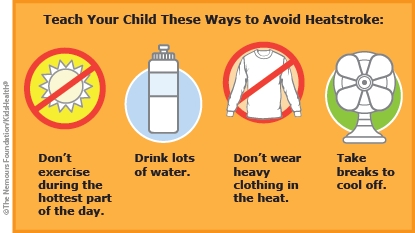Heatstroke: How to Care for Your Child
Heatstroke happens when someone's body heats up to dangerous levels. Your child was treated in the hospital and is now ready to go home. Here's how to care for your child and prevent heat-related illnesses in the future.


As your child recovers from heatstroke:
-
Your child will be more sensitive to heat-related illnesses while they recover. Don't let your child be in hot conditions until you follow up with your health care provider and they say it's OK.
-
Keep your child out of sports until they're cleared by your health care provider.
-
Let your child rest as needed.
-
Make sure they drink plenty of liquids. They can drink water, but your health care provider also may recommend drinking liquids with salt in them (such as oral electrolyte solutions or sports drinks) or adding salt to their food.
-
Have them take any supplements or vitamins as recommended by your health care provider.
-
Help them avoid caffeine, which draws water out of the body through pee.
-
Offer a regular diet. If your health care provider recommends it, add more salt to your child's diet.
-
If your child had muscle cramps and has sore muscles, you can try:
-
gentle massage and stretching of the sore muscles
-
having them take a warm bath
-
applying a heating pad or ice wrapped in a towel on the sore muscles
-
helping your child relax (for example, through deep breathing or meditation)
-
medicines such as acetaminophen (Tylenol® or a store brand) or ibuprofen (Advil®, Motrin®, or a store brand) if your health care provider says it's OK. Follow the directions on the label for how much to give and how often.
-
Take your child to any follow-up care visits as instructed by your health care provider.

Your child:
-
doesn't continue to feel better every day
-
is exercising in hot conditions and has symptoms of a heat illness such as muscle cramps, extreme thirst, weakness, lightheadedness, headache, nausea, vomiting, or diarrhea

Your child seems uncoordinated, has tight muscles, isn't speaking normally, has memory problems, or has changes in behavior.

How can we prevent heatstroke and other heat illnesses? Encourage your kids to:
-
Drink plenty of liquids. Health care providers might recommend that kids who do endurance sports (such as football, running, tennis, or soccer) or exercise in hot weather drink liquids with salt in them (such as oral electrolyte solutions or sports drinks) or add salt to their food. Ask your health care provider about the right amount of salt for your child.
-
Start slowly when exercising in hot weather. They should increase how long and hard they exercise gradually (over at least a week) so their body can adjust.
-
Avoid exercising outside between noon and 6 p.m., the hottest part of the day.
-
Take frequent breaks when exercising in the heat.
-
Wear sunscreen. Sunburned skin can worsen heat illness.
-
Dress in light clothing and only wear the minimum gear needed to stay safe when exercising in hot weather. For example, at football practice when working on endurance through running, they can take off their helmet and padding.
-
Avoid exercising in the heat when sick or taking any new medicines, especially if they have a fever.
-
Avoid caffeine.
-
Take any supplements or vitamins as recommended by your health care provider.
Other safety tips:
-
Don't ever leave kids alone in a parked car. Even on a mild, sunny day, temperatures inside a car can reach dangerous levels.
-
Talk to your health care provider and coaches before your child starts any exercise plan if they are overweight, have been diagnosed with sickle cell trait or another medical condition, or take any medicines.
-
Talk to kids about the dangers of heat illness. Teach them that they should stop exercising and cool off right away if they feel extremely hot or thirsty, weak or tired, or have cramps or other symptoms.
-
Be sure all your child's coaches and athletic trainers understand the dangers of heat illness and that they take safety precautions when the weather is very hot or humid (such as shortening or canceling practice or moving practice indoors).